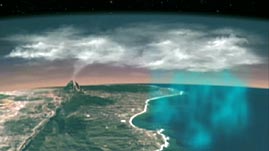Teachers' Domain - Digital Media for the Classroom and Professional Development
User: Preview


Source: FRONTLINE/NOVA: "What's Up With the Weather?"
Earth's relatively stable and hospitable average temperature is the result of a phenomenon called the greenhouse effect. The presence in the atmosphere of naturally occurring compounds, known as greenhouse gases, maintains Earth's temperature. This video segment adapted from NOVA/FRONTLINE describes how human activities are increasing greenhouse gas concentrations and explains what effect this might have on global temperatures.
Global Warming: The Physics of the Greenhouse Effect (Audio Description) (Video)
Scientific evidence has convinced most experts that there is a connection between global warming and human activities. Since the start of the Industrial Revolution, the average temperature of the planet has increased by slightly less than one degree Celsius to its present level of about 16°C (60°F). This seemingly insignificant change represents a fairly rapid warming trend. According to the UN-sanctioned Intergovernmental Panel on Climate Change, by the end of the twenty-first century, Earth's inhabitants will be facing temperatures that are at least two degrees Celsius — and possibly as much as six degrees — warmer.
To understand how human activities might cause global warming, we must first explore why our planet is warm in the first place. As solar radiation from the Sun reaches Earth's surface, some of it is reflected back into space and some of it is absorbed. The absorbed energy warms Earth's surface, which in turn radiates the energy back toward space. Molecules in the atmosphere, known as greenhouse gases, absorb some of this outgoing energy and radiate a portion of it back to Earth's surface. Through these two actions, they slow the escape of heat and keep Earth warmer than it would be otherwise.
When the concentration of greenhouse gases in the atmosphere increases, the atmosphere is capable of absorbing more energy. As a result, the planet warms up — until it reaches the temperature at which it again radiates just enough energy to keep the temperature stable. The higher the concentration of greenhouse gases in the atmosphere, the warmer the planet becomes before it reaches the point at which it radiates all the energy it receives and the temperature again stabilizes. Consequently, an increase in greenhouse gas concentrations — whether as the result of natural causes or human activities — causes the average global temperature to rise.
Scientists have documented changes in atmospheric carbon dioxide (CO2), one of the four most important greenhouse gases, over the past 400 million years. Their findings show a strong correlation between CO2 concentrations and global climate over geological history. Of course, atmospheric and climate changes in Earth's distant past have been unrelated to human activities. Most peaks in atmospheric carbon dioxide concentrations, for example, are attributed to the movement of carbon stored on Earth's surface — on land and in oceans — into the atmosphere through natural processes such as volcanic eruptions. However, scientists have found no such natural causes for the dramatic increase in CO2 observed since the Industrial Revolution.
Instead, human activities are the main source of CO2 and other greenhouse gases. Burning wood and fossil fuels such as gas, coal, and oil contributes carbon dioxide; livestock and coal production add methane; and agricultural and industrial processes add nitrous oxide. While oceans and land plants absorb a portion of these gases, the rest accumulate in the atmosphere, where they strengthen the greenhouse effect and cause the average global temperature to increase.
To learn more about evidence of regular, extreme climate change throughout Earth's distant past, check out Climate Change, Greenland Ice Sheet Project 2: A Record of Climate Change, and Natural Climate Change in Djibouti, Africa.
To learn more about the role CO2 plays in Earth's temperature, check out Global Warming: Carbon Dioxide and the Greenhouse Effect.
To learn more about evidence suggesting a link between human activities and global warming, check out CO2 Concentrations at Mauna Loa Observatory, Hawaiʻi and Earth System: Ice and Global Warming.
 Loading Standards
Loading Standards Teachers' Domain is proud to be a Pathways portal to the National Science Digital Library.
Teachers' Domain is proud to be a Pathways portal to the National Science Digital Library.
